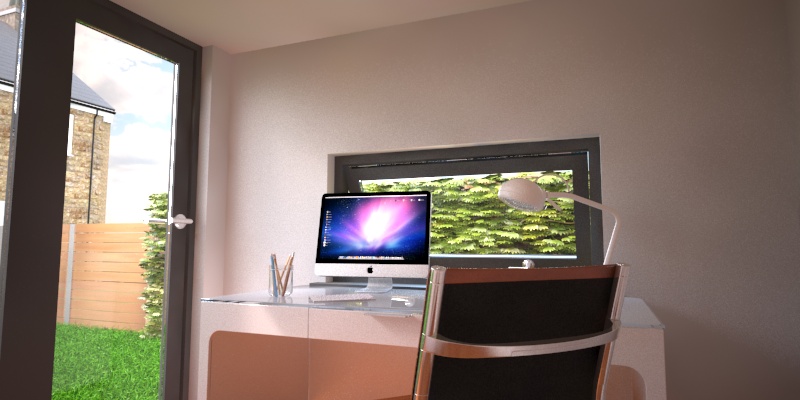We have worked from a garden office for many years now. Before that we designed and built many garden office buildings throughout the UK. This experience has shown us that there are some key elements that make a garden office a useable workspace all year round.
We thought we would share with you our observations so that you can think about them for your own garden office project.
Our top garden office usability tips
Heating – So far the 2015/16 winter has been very mild, but we are still pleased that we have the option of having the heating on as we sit here in Garden Office HQ! Many people ask us “are garden offices warm in winter?” and our answer is that thanks to the high levels of insulation, double glazing and heating they certainly are.
In our research of the garden office market we have seen that some suppliers quote that their buildings are ‘so well insulated no additional heating is required’. Whilst we don’t doubt that their buildings are highly insulated our experience is that a heater will still be needed for the coldest days of the year.
When buying a garden office you will have several choices when it comes to the heating used. Most suppliers will have their preferred type of heating which they will have chosen carefully. You will often be able to specify a different type of heating during the design process if thats what you want.
The most common heating systems for garden offices are electric convector heaters which are normally slim panels fixed to the wall. Oil filled radiators which look like old fashioned radiators which are often on wheels so you move them around the office. Infrared heating is another option, people like it because it heats objects rather than the air so is energy efficient. Underfloor heating is a popular option because its so discreet and allows you to position furniture where you want. The final and most expensive option is air conditioning – I know this tip is about heating rather than cooling, but remember that an air conditioning unit can be used to heat a room as well as cool it.
Most of the heating systems used in garden office design come with programmable timers so you can specify when the heating is actually on and at what temperature. Here at Garden Office HQ we have our heating programmed to come on around an hour before we start work and it switches off just after we leave in the evening.
Some garden office suppliers offer heating systems you can control with your smart phone, whether this be using an app or something as simple as sending a text to your office.
Ventilation – the flip side of a well insulated and heated garden office is there are times when you will want a little air to circulate around the room. To enable this easily we suggest you include an opening window into your garden office design. This may seem an obvious feature, but fixed pane floor to ceiling glazing has become so popular that sometimes no opening window is included in a garden office design.
Natural light – one of the things we like about working in our garden office is the large expanses of glass which flood our room with natural light. Our layout means we have sections of glazing on the south, east & west elevations of the office meaning we have good light as the sun moves around. We have avoided light on the north elevation as this is considered a cold light.
Artificial light – so we have advised you to maximise your natural light now we are going to suggest you think carefully about artificial light! Well its a dark January day as we type this article and the natural light we have is not of the best quality, so we are pleased we have good ambient and task lighting to aid our work.
Your garden office will come with a form of ambient lighting as standard. This may be in the form of track spot lights or lights set into the ceiling. LED lighting has become very popular as ambient lighting with garden office designers and offers a good quality general light.
As an extra you may want to consider some task lighting. If you know where you will need this at the design stage your supplier may design some in for you, or at least ensure there is a power point in the right position. Otherwise task lighting is an easy retro fit option.
Shading – in the height of the summer when the sun is at its highest you may be grateful of some natural shading so as to soften and cool the light in your garden office.
The actual design of your office can help out here. If you have chosen a design that features a deep eaves detail this will offer a degree of natural shading. You can create similar effect by positioning your office near a deciduous tree – the leaves will shield you in summer but not block out the valuable winter light.
A very simple shading solution is to include blinds at your windows. Most suppliers offer this option. Some sophisticated designs actually have the blinds fitted within the double glazing!
Data cabling – your garden office will be fully wired for power and light but you will probably have to specify data cabling as an optional extra. Some garden office owners opt to tap into their home wifi for their garden office, but this can be patchy depending on how far away your office is from your router. Also the high levels of insulation in a garden office can interrupt wifi signals – the last thing you want with a garden office is patchy connections.
We therefore urge you to consider specifying data cabling when you order your garden office. Typically owners include connections for broadband, telephone and television. Some owners also include cabling for alarms and entry systems so they can monitor deliveries at the front door from the comfort of their office at the bottom of the garden.
By specifying data cabling today you will be taking a step towards future proofing your garden office – after all we are becoming more and more dependent on technology.
So, these are our tips for creating a useable garden office. Combine them into your design and your will create a workspace that is productive environment all year round.


